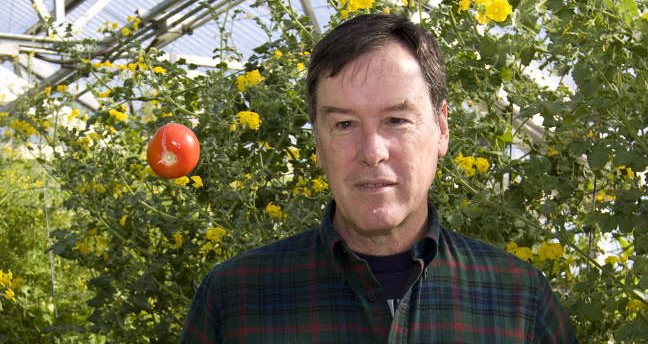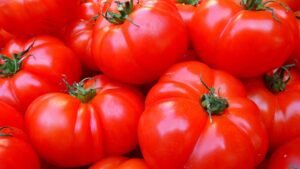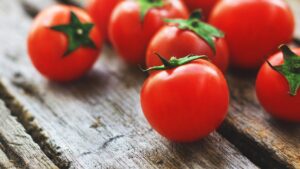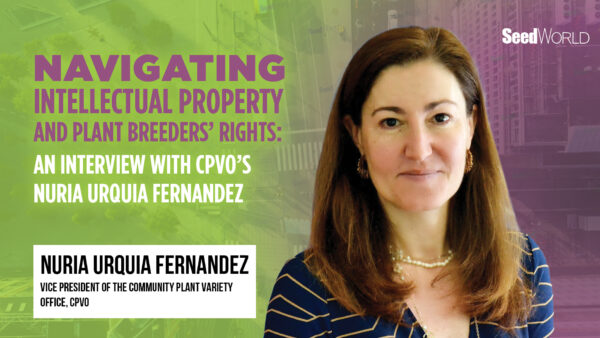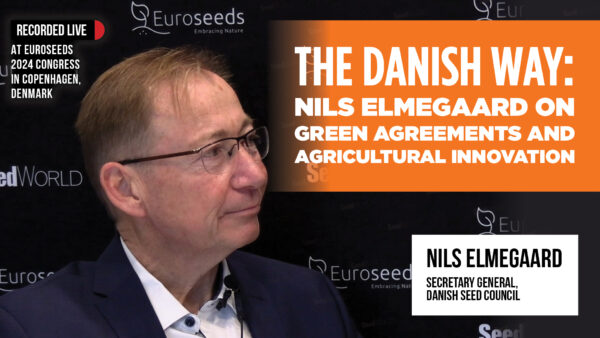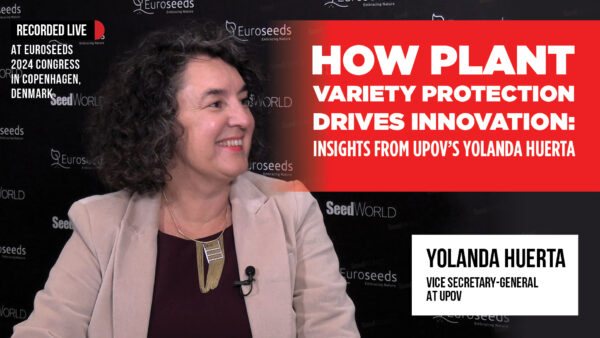According to researchers who spoke at the 2016 SolGenomics Conference, the future is now for this indispensable fruit.
The tomato is a crucial ingredient in a plethora of the world’s cuisine, which excites researchers like the University of Florida’s Harry Klee, who is on a mission to help plant breeders bring the first designer tomatoes to market.
Klee and his research team have figured out exactly what makes certain tomato varieties taste good to certain people, and are on the cusp of giving breeders the tools they need to literally design new tomato varieties with specific consumers in mind.
“I think everyone is in agreement that many modern tomato varieties don’t taste as good as heirloom varieties,” says Klee, a professor in the Horticultural Sciences Department’s Plant Molecular and Cellular Biology Program.
“We determined the main reason they’re not as good is they have low levels of certain flavor chemicals relative to the old varieties. That gives us a roadmap for what flavor compounds we want to manipulate, and how much we need to increase them to get the flavor back to where it can be.”
Partnering with Chinese researchers, Klee and his team have sequenced the genomes of 400 tomato varieties and identified the genetics of tomato flavor. The result is that breeders will be able to literally “repair” the flavor of tomatoes — flavor that’s been lost through years of breeding with mostly yield in mind.
“We’re really beginning to figure out how to restore that flavor,” Klee says.
He spoke about his new research, which will soon be published, at the 2016 SolGenomics Conference in Davis, California, which took place Sept. 12-16. The annual event, in its 13th year, examines the latest advances in the applications of research to production of solanaceous crops, including tomato, pepper, potato, eggplant and petunia, to name a few
Tailored Tomatoes
Partnering with University of Florida plant breeders, Klee is one of the people who assisted tomato breeder Jay Scott in developing the Tasti-Lee tomato, a vine-ripened variety that “brings significant improvements to health, flavor and freshness in grocery store tomatoes,” according to the product website.
Klee’s new research, he says, will serve to accelerate the development of such varieties beyond anyone’s imagination.
Want to design a tomato that will go perfectly when used in spicy Mexican cuisine? How about one designed specifically to make the perfect spaghetti sauce? How about a tomato that will be prized by the ketchup industry? Breeders could soon be able to do it all.
“I’m hopeful in the next few years you’ll see this translating into better-tasting tomatoes. When we do consumer panels, we collect a lot of data on the individuals in the panel, and we’ve defined specific differences in the population based on age, sex and ethnicity,” Klee says.
And because different demographics tend to prefer different flavors when it comes to cuisine, the results of Klee’s research could be used to tailor new tomatoes to these groups.
“In practice, we can use the demographic data to come up with the ideal tomato for men, women, children, tomatoes that go well in European food, Hispanic food, you name it. That’s not far-fetched at all.”
He notes that such demographic data is used all the time to create scores of other products, so why not tomatoes?
“Walk down the soda aisle and look at all the different types of cola. You’ve got regular cola, diet cola, cola with a twist of lime, cherry cola. Different people have their favorite. In the not-too-distant future, we can do that with tomatoes. If you know the flavor attributes different people look for, you can optimize the flavor of the tomato for that demographic.”
In a nutshell, it’s sugars, acid and about 26 volatile chemicals that are responsible for the flavor profile of the tomato, according to Klee.
His new research is getting noticed. Not only was he a featured speaker at SolGenomics 2016, he says the feedback from various companies within the industry has been tremendous.
“For me, the take-home message is that breeders have not had tools to effectively screen for flavor. It’s very complicated. A breeder can’t walk through a field and taste 1,000 tomatoes and pick the one that’s the best. It’s physically impossible,” he adds.
“What we’re trying to do is reduce good flavor down to a set of molecular markers they can use without having to know much about flavor at all.”
The research will also have positive effects on yield as well. Klee and his team have already bred a tomato that’s a cross between one of the parents of Tasti-Lee and an heirloom variety. He says it’s got all the flavor of a classic heirloom tomato, but with double the yield.
“It’s a much stronger plant,” he says.
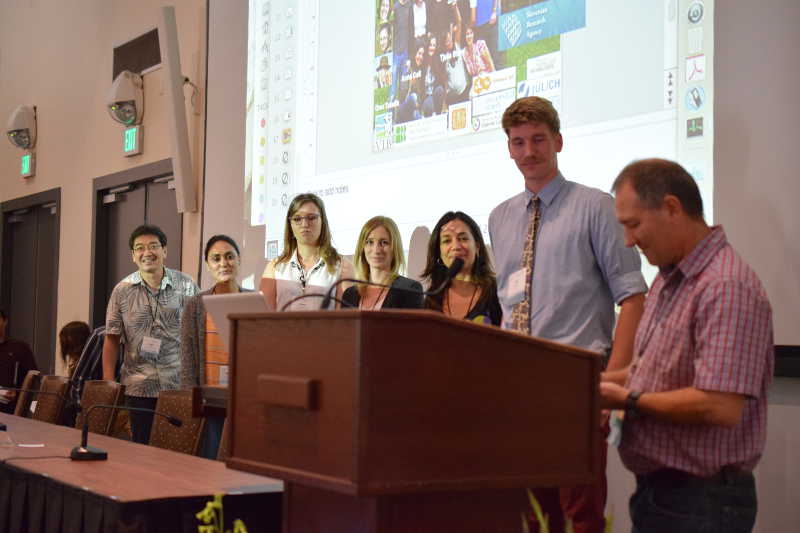
SolGenomics Conference More than Just Tomatoes
This year’s SolGenomics Conference featured an array of speakers, who talked about the latest advances in the field. It wasn’t just tomatoes on the agenda. A lot of the talks were about the use of CRISPR/Cas9 in the other crops, especially potato. Topics ranged from genetic diversity in a wide array of Solanaceous crops, high-throughput phenotyping, genomics, gene editing, root and tubers to systems biology and workshops.
There was also a focus on how all of the Solanaceous crops are taking advantage of the broad diversity of their wild relatives to improve economically important traits — from S. pimpinellifolium in tomato, to S. etuberosum in potato, to landraces of C. annuum, all the way to Physallis sp. for tomatillo.
Among the speakers was Roger Chetelat, director of the C.M. Rick Tomato Genetics Resource Center at the University of California, Davis, whose keynote speech paid homage to the center’s namesake, the late Charles Rick.
During his 60-year career at UC-Davis, Rick isolated and mapped hundreds of mutants, collected wild tomato relatives throughout South America, and founded a seed bank to preserve these and other stocks. His work helped establish the tomato as a model system for genetic studies, and made available rich germplasm resources with which to analyze the Solanum genome.
“It’s Charlie’s stuff that forms the foundation of a lot of what we’ve done,” Klee says.
Randi Jiminez, a horticulture student who helped manage the event’s Twitter account, notes that, “part of why Charlie Rick’s work was so foundational [to the work on Solanaceous crops] is that the germplasm he collected is what so much of this work uses.”
The conference enjoyed its best attendance ever this year. According to organizer Allen Van Deynze, 360 people showed up for the event, which took place in the United States for the first time over a decade. It will take place in Valencia, Spain, next year.
“The conference shifted closer to the plant breeding side of things this year — it was a good mix of basic researchers and applied researchers. That could be why we got more people, since we tapped into a broader community than in the past,” Van Deynze says.
It was also the first year the event took to Twitter with its own account, @SolGenomics2016. UC-Davis horticulture student Randi Jimenez and Don Gibson managed the account, which updated followers throughout the event.
“It worked really well to keep people informed and help them share information back and forth,” she says.
An added benefit, she notes, is that the Emoji used by Twitter and most smartphones include a fairly wide swath of the solanaceous crops, making an event like the SolGenomics Conference even more appropriate for Twitter.
“Thank goodness Twitter has a tomato and a pepper and a petunia Emoji. There’s no potato, but we used a French fry Emoji for that,” she says with a laugh.


